We are a synthetic inorganic and organic materials research group focusing on task-specific design and functionalization of advanced porous materials. The space within nanoporous materials provides virtually unlimited room for imagination, allowing designed incorporation of different functionalities for numerous potential applications. The research of our group aims to engineering the nanospace of advanced porous materials including metal-organic frameworks (MOF), covalent organic framework (COF) and porous organic polymer (POP) for energy/biological/environmental-related applications centered on the following topics:
|
||
| 1. Rational design and functionalization of MOF materials for catalysis | ||
| 2. Exploration of mesoporous MOF/COF as a new type of platform for enzyme/protein immobilization | ||
| 3. Development of functional porphyrin-based framework materials | ||
| 4. Task-specific design and functionalization of COF/POP materials for water treatment | ||
| 5. Rational design and functionalization of COF/POP materials for catalysis | ||
| 6. Rational design and functionalization of MOF/POP/COF materials for gas storage and gas separation | ||
| 7. Targeted synthesis of microporous carbon and nanostructured materials from MOFs/COFs/POPs | ||
1. Rational design and functionalization of MOF materials for catalysis |
||
Metal-organic frameworks (MOFs) are highly crystalline inorganic-organic hybrids, and they are constructed by assembling metal ions or metal-containing clusters with multidentate organic ligands via coordination bonds into a three-dimensional structure. Our interest lies in rational design and functionalization of MOFs for applications in catalysis with focus on: (1) Development of MOFs as a new platform for CO2 chemical transformation (2) Exploration of MOFs as a new paradigm for small molecule activation (3) Development of MOFs as a new type of solid acid catalysts (4) Development of new methodologies to encapsulate functionalized species into the nanospace of MOFs for catalysis
|
||
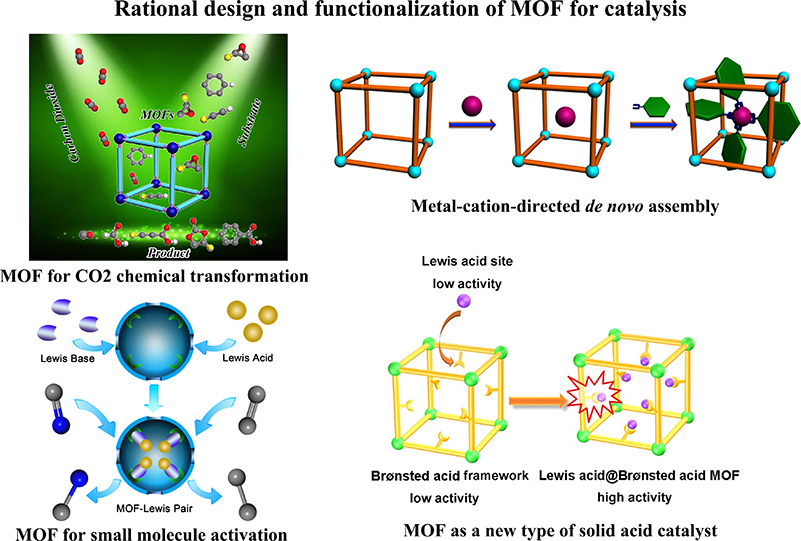 |
||
Representative publications: Angew Chem. Int. Ed., 2014, 53, 2615-2619 (pdf); J. Am. Chem. Soc., 2014, 136, 1202-1205 (pdf); J. Am. Chem. Soc., 2015, 137, 4243-4248 (pdf); Angew Chem. Int. Ed., 2016, 55, 5472-5476 (pdf); Small. 2016, 12, 6309-6324 (pdf); Angew Chem. Int. Ed., 2018, 57, 4657-4662 (pdf); Angew Chem. Int. Ed., 2018, 57, 10107-10111 (pdf); Chem, 2018, 4, 2587-2599 (pdf); Angew Chem. Int. Ed., 2019, 58, 7420-7424 (pdf). Up |
||
| 2. Exploration of mesoporous MOF/COF as a new type of platform for enzyme/protein immobilization | ||
Enzymes are becoming increasingly important in sustainable technology and green chemistry due to their wide applications in various fields such as pharmaceuticals, chemical/fine-chemical syntheses, food industries, biosensors, biofuel cells, nanobioelectronics, etc. However, the application of enzymes in those fields, particularly as biocatalysts that feature high reactivity, selectivity, and specificity under mild conditions, is usually hampered by their low operational stability, difficult recovery, and lack of reusability. Immobilization of enzymes/proteins on solid supports can enhance enzyme stability as well as facilitate separation and recovery for reuse while maintaining activity and selectivity. Mesoporous MOFs/COFs (mesoMOFs/COFs) merit high surface areas and pore walls composed of functional organic groups which could afford specific interactions with protein/enzyme molecules thus avoiding leaching. This makes them very promising to be developed as a new type of host matrix materials to immobilize proteins/enzymes for biocatalysis applications as well as to understand the behaviors of proteins/enzymes in biological systems.
|
||
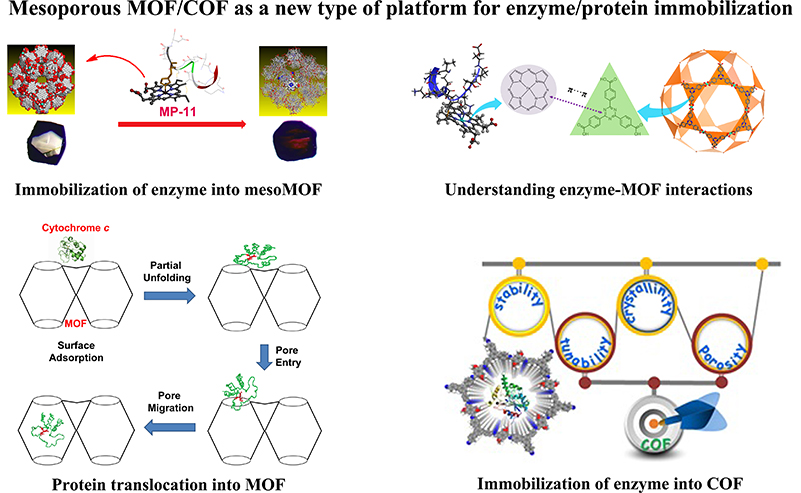 |
||
Representative publications: J. Am. Chem. Soc. 2011, 133, 10382-10385 (pdf); J. Am. Chem. Soc., 2012, 134, 13188-13191 (pdf); Inorg. Chem., 2014, 53, 10006-10008 (pdf); Dalton Trans., 2016, 45, 9744-9753 (pdf); ACS Appl. Mater. Interfaces. 2017, 9, 10874-10881 (pdf); J. Am. Chem. Soc., 2018, 140, 984-992 (pdf); Angew Chem. Int. Ed. 2018, 57, 16754-16759 (pdf); J. Am. Chem. Soc., 2018, 140, 16032-16036 (pdf); Adv. Mater. 2019, 31, 1900008 (pdf); Chem, 2019, 5, 3184-3195 (pdf). Up |
||
Porphyrin/metalloporphyrins are one of the cornerstones on which the existence of life is based, and essential biochemical, enzymatic, and photochemical functions depend on the special properties of the tetrapyrrolic macrocycle. Given the ubiquitous biological functions of metalloporphyrins in nature (for example light-harvesting, oxygen transportation and catalysis), building coordination architectures using custom-designed porphyrin ligands becomes exceedingly desirable in pursuance of mimicking their diverse biological functionalities. Our focus lies in rationally designing porphyrin-based framework materials inlcuding metal-metalloporphyrin frameworks (MMPFs), porous covalent porphyrin frameworks (PCPFs) followed by developing them for applications in heterogeneous catalysis, photocatalysis, light harvesting, etc.
|
||
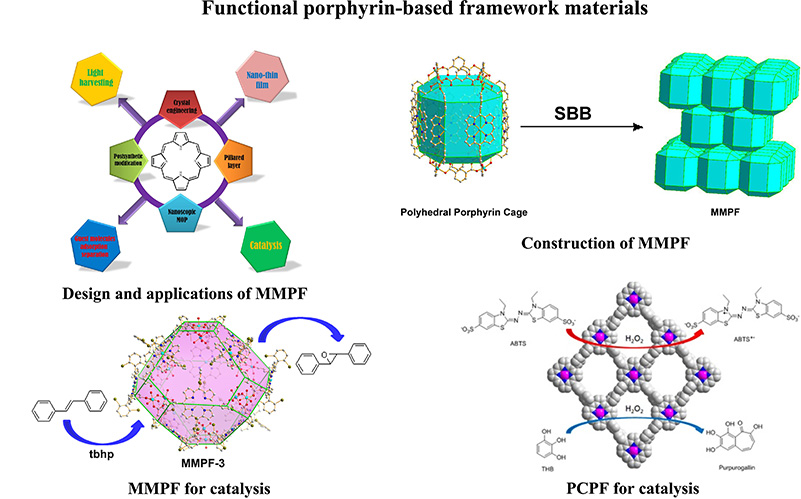 |
||
Representative publications: J. Am. Chem. Soc., 2011, 133, 16322-16325 (pdf); Angew Chem. Int. Ed. 2012, 51, 10082-10085 (pdf); Chem. Sci., 2012, 3, 2823-2827 (pdf); Chem. Eur. J., 2013, 19, 3297-3301 (pdf); Chem. Mater. 2014, 26, 1639-1644 (pdf); Chem. Soc. Rev., 2014, 43, 5841-5866 (pdf); Inorg. Chem., 2016, 55, 7291-7294 (pdf); ACS Appl. Mater. Interfaces, 2016, 8, 18173-18181 (pdf); Chem. Commun, 2018, 54, 1170-1173 (pdf); Nature Commun. 2019, 10, 1913 (pdf); J. Am. Chem. Soc., 2019, 141, 14443-14450 (pdf); Angew Chem. Int. Ed., 2020, 59, 4354-4359 (pdf). Up |
||
|
||
| 4. Task-specific design and functionalization of COF/POP materials for water treatment | ||
Clean water is essential for all life forms to thrive, but when this life sustaining-source is contaminated by natural events or anthropogenic activities it becomes imperative to know the contaminant (detection) and rectify (decontamination) it to safe levels. Featuring framework robustness (high water/chemical stability) as well as amenability to design and functionalize, COFs/POPs hold great promise as a new type of water decontamination materials. We are interested in task-specific design and functionalization of COF/POP-based “nano-traps” for water treatment with focus on: (1) Heavy metal removal (2) Removal of oil and micro-pollutants (3) Uranium extraction from seawater (4) Radionuclide sequestration
|
||
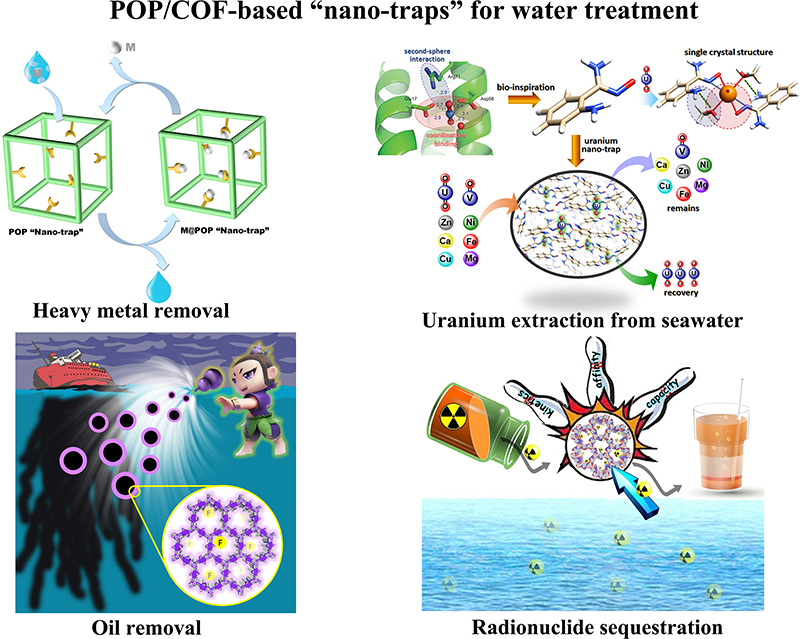 |
||
| Representative publications: Nat. Commun. 2014, 5, 5537 (pdf); Chem. Sci., 2016, 7, 2138-2144 (pdf); Adv. Mater. 2017, 29, 1700665 (pdf); J. Am. Chem. Soc., 2017, 139, 2786-2793 (pdf); Nat. Commun. 2018, 9, 1644 (pdf); Adv. Mater. 2018, 30, 1705479 (pdf); Chem, 2018, 4, 1726-1739 (pdf); Trends in Chemistry 2019, 1, 292-303 (pdf); ACS Central Science, 2019, 5, 1352-1359 (pdf); Nature Commun. 2019, 10, 1646 (pdf). Up | ||
|
||
| 5. Rational design and functionalization of COF/POP materials for catalysis | ||
Porous organic polymers (POPs) including covalent organic frameworks (COFs) have recently been advanced as a new type of porous materials for a broad range of applications. Given the fact that their nanospace can be decorated with various functionalities, we are interested in rational design and functionalization of COF/POP as a new type of platform for heterogeneous catalysis. |
||
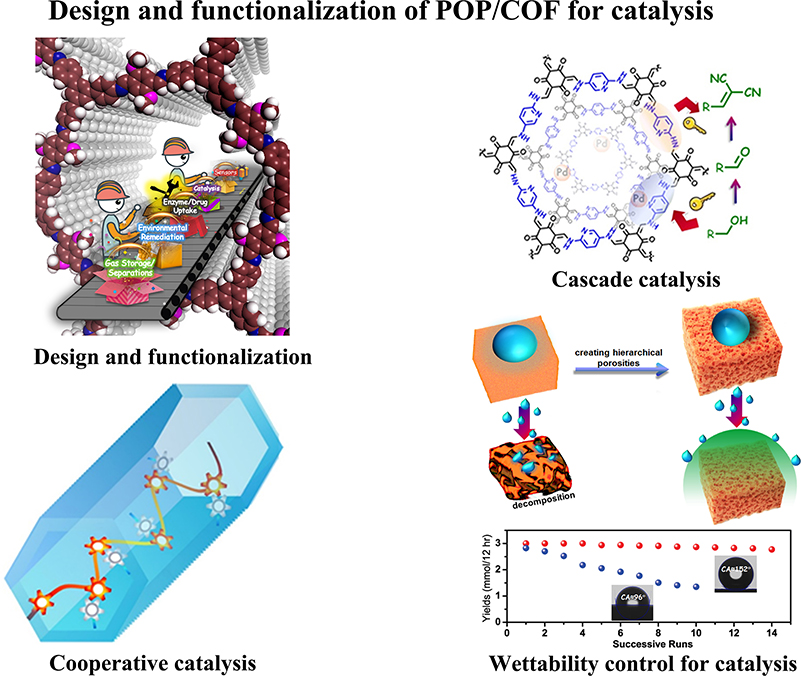 |
||
| Representative publications: Chem. Commun. 2014, 50, 8507-8510 (pdf); Chem, 2016, 1,628-639 (pdf); J. Am. Chem. Soc., 2016, 138, 15790-15796 (pdf); ACS Catal., 2017, 7, 1087-1092 (pdf); Mater. Chem. Front., 2017, 1, 1310-1316 (pdf); ACS Appl. Mater. Interfaces, 2019, 11, 3070-3079 (pdf); ACS Sustainable Chem. Eng., 2019, 7, 4878-4888 (pdf); Angew Chem. Int. Ed., 2019, 58, 8670-8675 (pdf); Nature Commun. 2019, 10, 3059 (pdf); Matter, 2020, 2, 416-427 (pdf). Up | ||
| 6. Rational design and functionalization of MOF/POP/COF materials for gas storage and separation | ||
Emerging as new classes of porous materials, MOFs/COFs/POPs feature high surface area, tunable pore sizes, and functionalizable pore walls, which make them be explored at the forefront for applications in gas storage and separation. Our interest lies in rational design and functionalization of MOFs/COFs/POPs for applications in hydrogen/methane storage at ambient temperatures, targeted gas separations, and removal of toxic/harmful gases. |
||
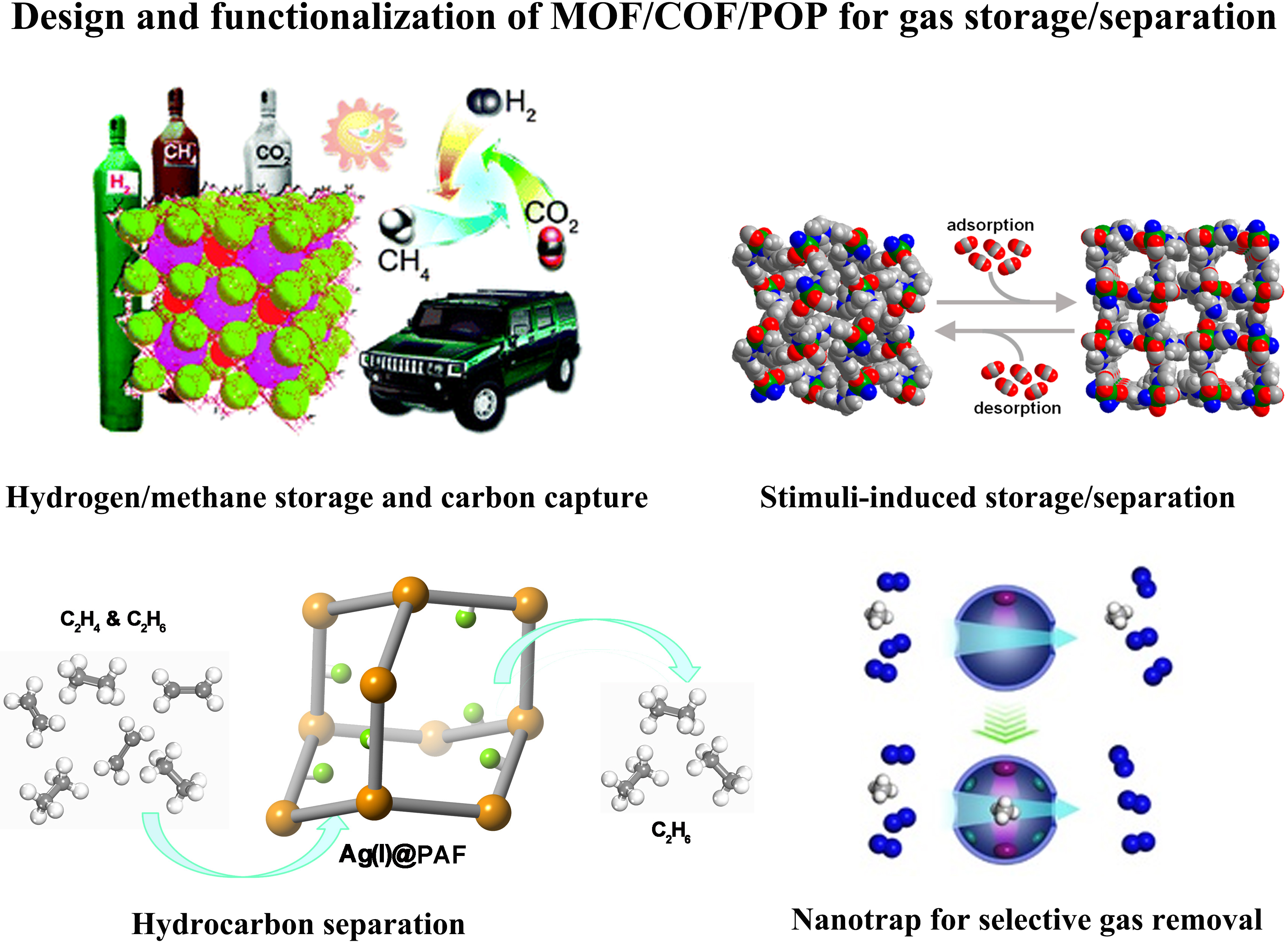 |
||
| Representative publications: Chem. Commun., 2010, 46, 44-53 (pdf); Chem. Commun., 2012, 48, 8898-8900 (pdf); Nature, 2013,495, 80-84 (pdf); J. Am. Chem. Soc., 2014, 136, 8654-8660 (pdf); Chem. Commun., 2015, 51, 2714-2717 (pdf); Chem. Commun., 2015, 51, 9636-9639 (pdf); J. Am. Chem. Soc., 2015, 137, 14875-14876 (pdf); Inorg. Chem., 2016, 55, 9071-9076 (pdf); ACS Central Science, 2018, 4, 1194-1200 (pdf); J. Mater. Chem. A, 2019, 7, 13585-13590 (pdf); Chem. Sci., 2019, 10, 6661-6665 (pdf); Angew Chem. Int. Ed., 2019, 58, 10138-10141 (pdf); Chem. Soc. Rev., 2020, 49, 708-735 (pdf). Up | ||
| 7. Targeted synthesis of microporous carbon and nanostructured materials from MOFs/COFs/POPs | ||
Porous carbons and nanostructred materials represent important classes of materials and have been widely utilized for a range of applications. Our interest lies in the employment of MOFs/COFs/POPs as precursors for the synthesis of microporous carbon materials and nanostructred oxide materials for applications in fuel cells, carbon capture, and energy storage.
|
||
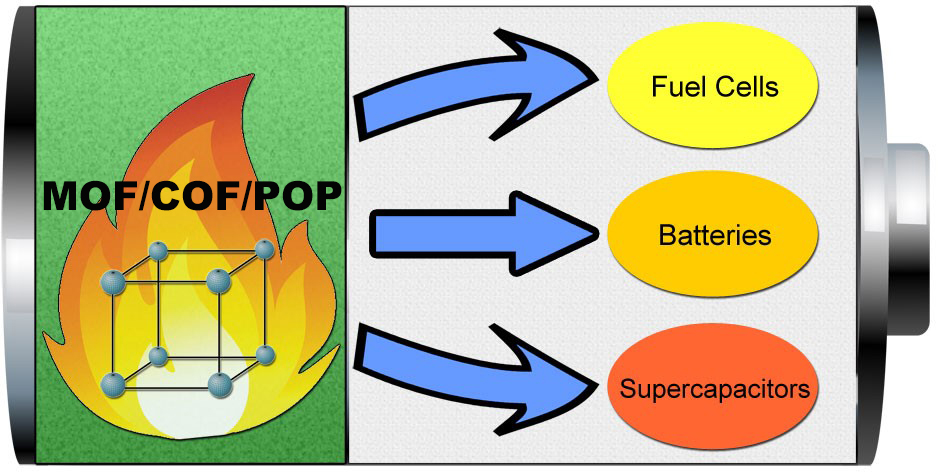 |
||
Representative publications: Chem. Eur. J. 2011, 17, 2063-2067 (pdf); Chem. Commun., 2013, 49, 10269-10271 (pdf); CrystEngComm, 2015, 17, 10-22 (pdf); Chem. Commun. 2015, 51, 8683-8686 (pdf); Chem. Commun. 2016, 52, 13897-13900 (pdf); Catal. Sci. Technol., 2018, 8, 5244-5250 (pdf); ACS Nano, 2018, 12, 4594-4604 (pdf); J. Mater. Chem. A, 2019, 7, 3624-3631 (pdf); ACS Nano, 2019, 13, 8087-8098 (pdf). Up |
||
